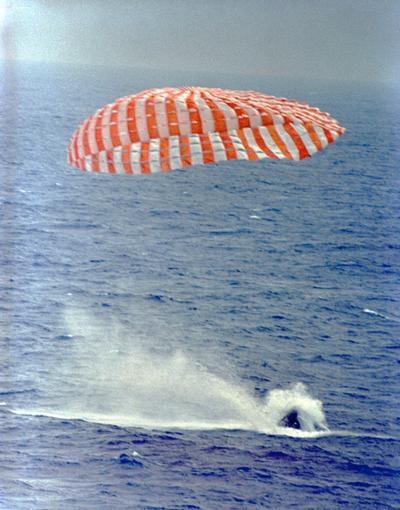For NASA, Everything Old Is New Again
By Wes Oleszewski, ANN Space Analyst
For three decades the exclamation point that ended every successful Space Shuttle mission was “Wheels Stop!” Many of you reading this may only associate that term with the successful conclusion of a United States human space mission. Yet those of us who grew up in the era of Apollo know a much older term; “Splashdown!”
From the first Mercury flights to the final mission of Apollo, each flight was ended with a joyful jolt to the crew as the spacecraft or capsule was lowered to the ocean’s surface by parachute. Its impact back on the surface of our planet was called a “splashdown” and marked the moment when the majority of the danger of flying is space was greatly reduced. Now, nearly 40 years after the last Apollo splashed down, the Orion spacecraft is about to return that term to NASA’s vocabulary.
Following its four hour, 23 minute and 29 second mission beyond low earth orbit, the Orion spacecraft will splashdown in the Pacific about 600 miles off the coast of Baja, California. Stationed there will be the US Navy’s amphibious ship USS ANCHORAGE along with the USNS SALVOR. Helicopters from the ANCHORAGE will deploy to locate and track the Orion as it descends toward splashdown. Following splashdown teams of divers will be deployed, not by helicopter as was done in Apollo, but by way of high-speed Zodiac boats. These divers will recover not only the Orion, but will also try and recover the vehicle’s parachutes and the apex cover that was jettisoned in order to deploy the chutes.
Like Apollo, the Orion carries a series of “righting bags” which look like large round balloons attached to the forward end of the vehicle. If the Orion should turn upside down after splashdown, the bags inflate and allow the vehicle to return to floating upright. The primary difference being that Apollo carried just three bags and Orion will use as many as five. Additionally, divers will attach a type of flotation collar similar to Apollo to the Orion. Now, however, that collar is officially called a “Load-distributing collar” for reasons that only the secret society of device-namers in NASA know. No doubt it too will become an acronym such as “LDC” because everything at NASA must be an acronym sooner or later. Finally a tether for towing and a “sea anchor” will be attached by the recovery divers. Of course, like Apollo, the “sea anchor” is not an anchor in the sense of that used to secure a ship. Rather it is a sort of underwater parachute that helps to stabilize the spacecraft.
It was 39 and one half years ago that a NASA spacecraft had the agency’s final splashdown with the Apollo-Soyuz Test Project in July of 1975. The public never saw any of the Mercury capsules splashdown live on TV because the satellites needed to relay those images back to the mainland were not yet in orbit. Later the first recovery televised live from the recovery carrier was that of Gemini 6. Unfortunately, both Gemini 6 and 7 splashed down out of range of the TV cameras. Gemini 8 aborted and landed in a contingency area, thus was not televised. So, the first ever splashdown that was broadcast on live TV was Gemini 9, although the long-range cameras caught it just at the moment of impact. In Apollo, the first two missions were not able to be seen by the television cameras on the carrier. Apollo 7 landed out of range of the cameras and Apollo 8 landed in pre-dawn darkness. Apollo 9 was the first time that television audiences saw an Apollo spacecraft descend and splashdown, but the event was at long range and the camera was shaking. Apollo 10 also landed in near pre-dawn darkness and was not visible to TV, yet the crews on the carrier were able to see it. Apollo 11, although watched by the largest TV audience in history was out of camera range at splashdown. Finally, people go a good look at an Apollo splashdown on their TV sets as Apollo 12 dropped through an overcast sky and was clearly seen by the cameras. Thereafter Apollo splashdowns got easier to view as later missions used photo-helicopters to spot and cover descents and splashdowns.
Each time that a splashdown was seen on TV it was an exclamation point attached to each flight and said “mission accomplished.” Of course eventually that mission accomplished tag was applied to all of Project Apollo and NASA moved on to the Shuttle and a new exclamation point.
NASA will now come full circle in their method of returning from space and the fans of spaceflight will again get to exclaim, “splashdown!” Sure, SpaceX has splashed several Dragon spacecraft, but they don’t let us see it live. Even their biggest fans are left with sanitized video snippets released from the SpaceX web site after the fact. NASA, however did cover the COTS 2 descent with some poor-quality, live video sent from a P3 chase plane, but the video dropped out just before splashdown. With any luck, NASA TV will cover the Orion splashdown live and the term will be brought back to NASA’s vocabulary as an exclamation point.
(Images provided by NASA)

